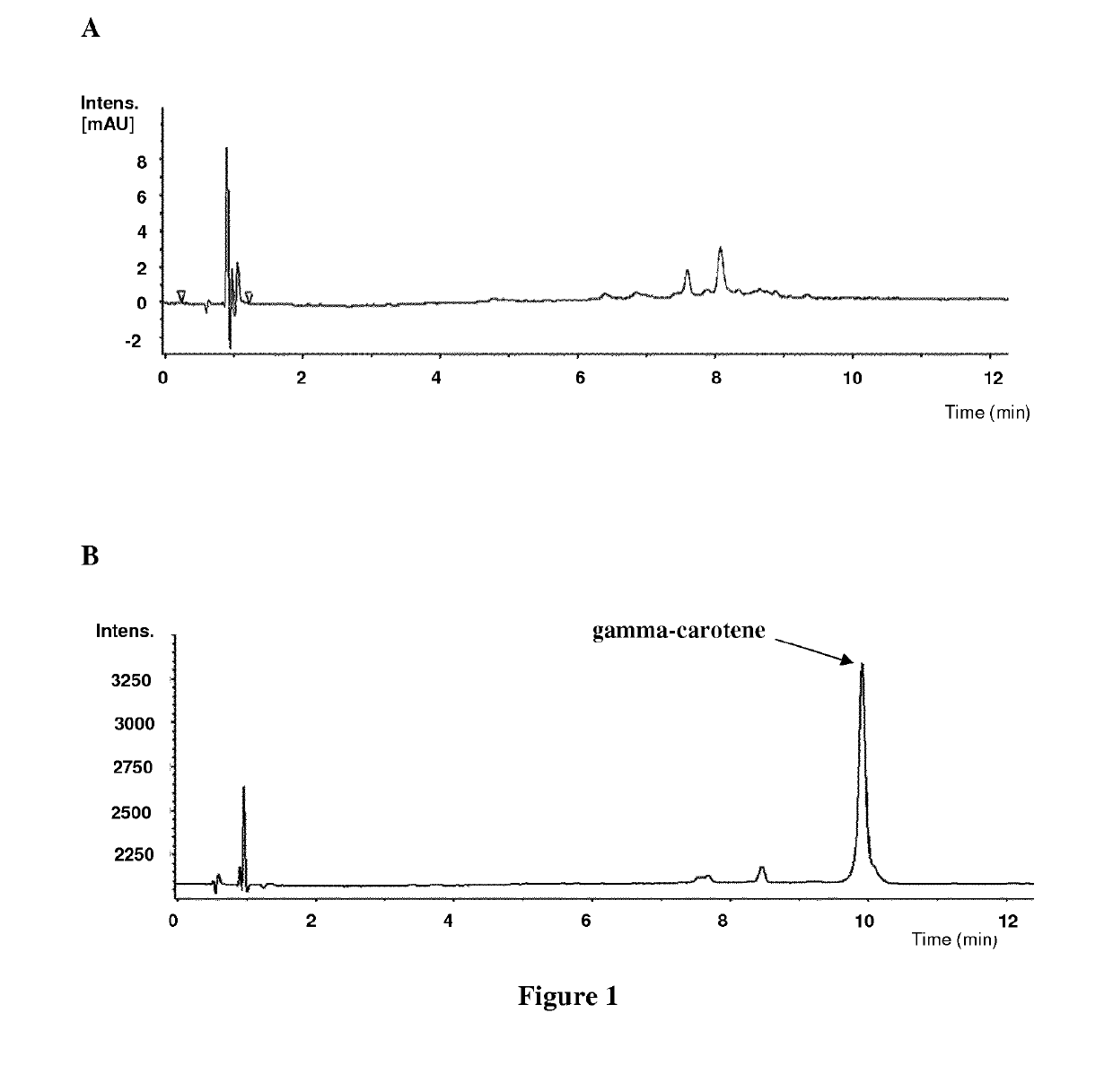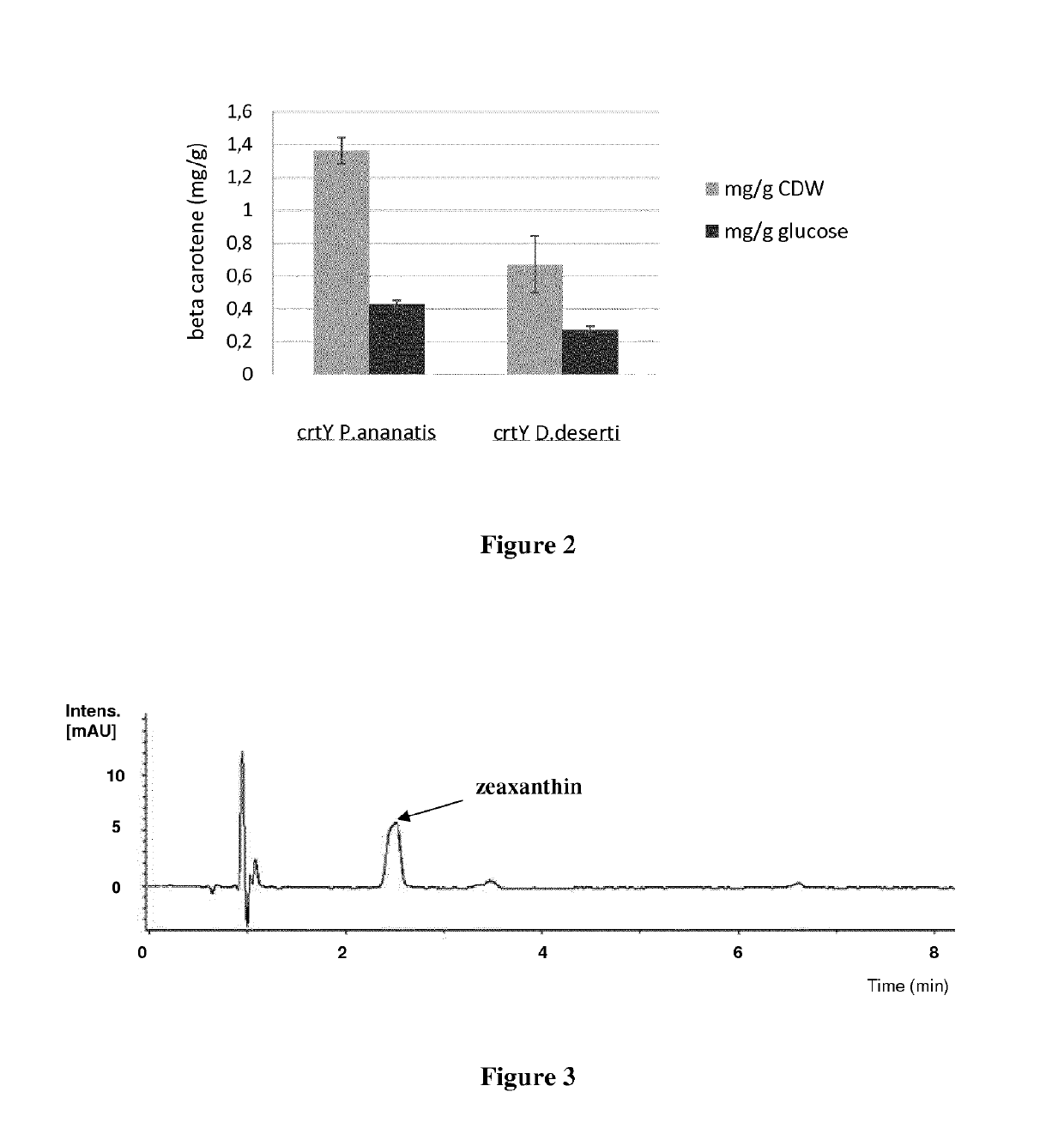Methods of producing astaxanthin or precursors thereof
a technology of astaxanthin and precursors, applied in the field of microorganisms, can solve the problems that the genetically modified bacteria do not allow a cost-competitive industrial production process, and achieve the effect of reducing the risk of microbial contamination and reducing the cost of subsequent steps
- Summary
- Abstract
- Description
- Claims
- Application Information
AI Technical Summary
Benefits of technology
Problems solved by technology
Method used
Image
Examples
example 1
n of γ-Carotene
[0219]A Deinococcus geothermalis strain was genetically engineered to produce gamma-carotene. This recombinant strain was obtained by disrupting a part of the carotenoid pathway. Indeed, the operon containing genes encoding LmbE like protein, carotenoid 3′,4′-desaturase (CrtD), glucosyltransferase (CruC), acyltransferase (CruD), C-1′,2′ hydratase (CruF) and carotene ketolase (CrtO), i.e. the operon extending from gene DGEO_RS14350 (old locus tag: Dgeo_2305) to gene DGEO_RS14375 (old locus tag: Dgeo_2310) (cf. NCBI Genbank: NC_008025.1, Deinococcus geothermalis, complete genome), was knockout. Moreover, the endogenous farnesyl pyrophosphate synthase (FPPS, E.C. 2.5.1.1, 2.5.1.10, 2.5.1.29) gene was overexpressed by replacing the endogenous fdps gene (DGEO_RS10825 (old locus tag: Dgeo_1618; NCBI Genbank: ABF45913) with a cassette comprising said gene placed under the control of a constitutive promoter. The resulting constructs were checked by sequencing. This strain was...
example 2
n of β-Carotene
[0223]A Deinococcus geothermalis strain was genetically engineered to produce beta-carotene. This recombinant Deinococcus geothermalis strain was obtained by further modifying strain A of example 1. Indeed, the gene encoding the lycopene beta-cyclase (CrtY, cyclizing lycopene into beta-carotene) from Pantoea ananatis (SEQ ID NO: 1) or from Deinococcus deserti (SEQ ID NO: 7) was inserted into the chromosome (replacing the phosphotransacetylase (pta) gene (DGEO_RS02840 NCBI Genbank: NC_008025.1) or the carotenoid operon extending from gene DGEO_RS14350 to gene DGEO_RS14375) and placed under the control of a constitutive promoter. The resulting constructs were checked by sequencing. The strain expressing CrtY from Pantoea ananatis was named strain B and the strain expressing CrtY from Deinococcus deserti was named strain C.
[0224]To make seed cultures, individual colonies were picked to inoculate 25 ml of CMG2% medium (Peptone 2 g / L; Yeast Extract 5 g / L; Glucose 55 mM (20...
example 3
n of Zeaxanthin
[0226]A Deinococcus geothermalis strain was genetically engineered to produce zeaxanthin. This recombinant Deinococcus geothermalis strain was obtained by further modifying strain B of example 2. Indeed, the gene encoding the beta-carotene hydroxylase (CrtZ) from Pantoea agglomerans (SEQ ID NO: 13) was inserted into the chromosome replacing transposase (IS200 / IS605) gene (DGEO_RS14195, (old locus tag: Dgeo_2273) NCBI Genbank: NC_008025.1) and was placed under the control of a constitutive promoter. The resulting constructs were checked by sequencing. This strain was named strain D.
[0227]To make seed cultures, individual colonies were picked to inoculate 25 ml of CMG2% medium (Peptone 2 g / L; Yeast Extract 5 g / L; Glucose 55 mM (20 g / L); MOPS acid 40 mM; NH4Cl 20 mM; NaOH 10 mM; KOH 10 mM; CaCl2.2H2O 0.5 μM; Na2SO4.10H2O 0.276 mM; MgCl2.6H2O 0.528 mM; (NH4)6(Mo7)O24.4H2O 3 nM; H3BO3 0.4 μM; CoCl2.6H2O 30 nM; CuSO4.5H2O 10 nM; MnCl2 0.25 μM; ZnSO4.7H2O 10 nM; D-Biotin 1 μ...
PUM
| Property | Measurement | Unit |
|---|---|---|
| temperature | aaaaa | aaaaa |
| temperature | aaaaa | aaaaa |
| temperature | aaaaa | aaaaa |
Abstract
Description
Claims
Application Information
 Login to View More
Login to View More - R&D
- Intellectual Property
- Life Sciences
- Materials
- Tech Scout
- Unparalleled Data Quality
- Higher Quality Content
- 60% Fewer Hallucinations
Browse by: Latest US Patents, China's latest patents, Technical Efficacy Thesaurus, Application Domain, Technology Topic, Popular Technical Reports.
© 2025 PatSnap. All rights reserved.Legal|Privacy policy|Modern Slavery Act Transparency Statement|Sitemap|About US| Contact US: help@patsnap.com



